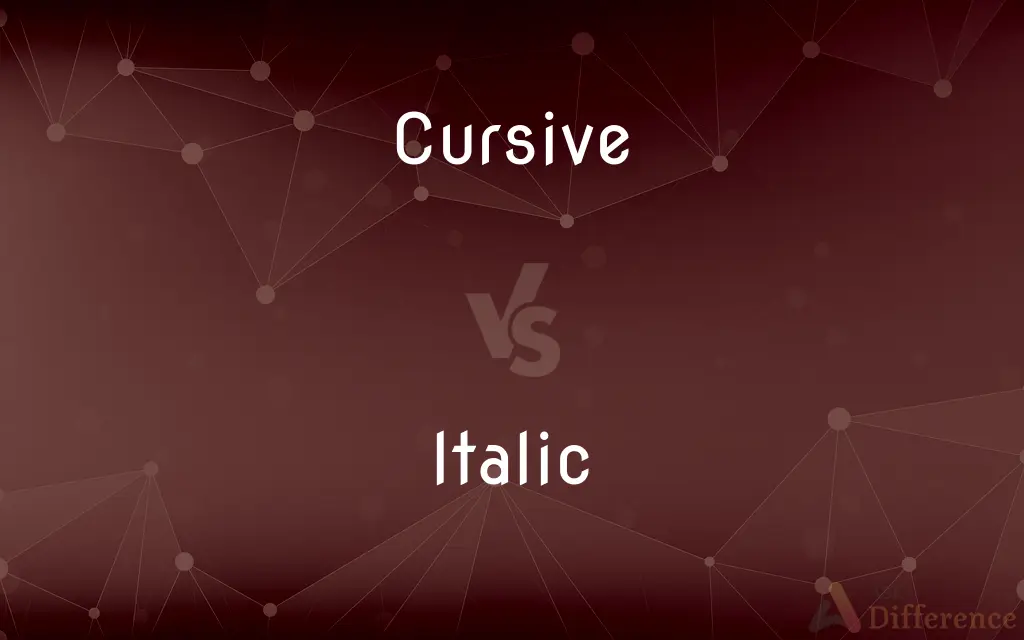Cursive vs. Italic — What's the Difference?
Edited by Tayyaba Rehman — By Maham Liaqat — Updated on March 30, 2024
Cursive writing is a style where letters are connected for faster handwriting, while italic typeface slants to the right, used for emphasis or differentiation in print.

Difference Between Cursive and Italic
Table of Contents
ADVERTISEMENT
Key Differences
Cursive writing is designed to facilitate speedy handwriting through the connection of letters, often with loops and flourishes. It is taught primarily in the early years of schooling to improve writing speed and fluidity. On the other hand, italic typeface is a style of printed letters that slant to the right, distinct from regular, upright text. Italic is often used to provide emphasis, denote titles, or distinguish certain words or phrases within a block of text.
While cursive is a handwriting style aimed at enhancing writing efficiency and artistry, italics in typography serve a more functional role in text organization and emphasis. Whereas cursive writing can vary significantly in appearance based on individual handwriting styles, italic typefaces are consistent and standardized across various fonts and publications.
The development of cursive writing was influenced by the need for quick and efficient writing techniques, particularly before the advent of typewriting and digital text. Italic typeface, however, originated in the early days of printing as a way to mimic the style of handwriting and to fit more text on a page, but it has evolved to serve various purposes in printed and digital media.
In digital writing and online content, the use of italics is straightforward and uniform, allowing for easy emphasis of text across different platforms and devices. Cursive writing in digital form is less common, typically appearing in specific contexts like digital signatures or stylistic choices in graphic design, where the personal touch or aesthetic of cursive is desired.
Comparison Chart
Purpose
Enhance writing speed and fluidity
Provide emphasis, denote titles, or differentiate
ADVERTISEMENT
Origin
Developed for handwriting efficiency
Originated in printing to mimic handwriting style
Appearance
Connected letters, often with loops and flourishes
Slanted text, consistent across different fonts
Usage Context
Handwriting, especially in early education
Printed and digital text, for emphasis or style
Digital Presence
Less common, used for signatures or design
Widely used across platforms for emphasis
Compare with Definitions
Cursive
Handwriting style connecting letters.
She practiced her cursive writing to improve its legibility.
Italic
Used for emphasis or distinction in text.
The key terms were highlighted in italic for easy identification.
Cursive
Characterized by flowing movements.
The cursive script on the invitation added a personal touch.
Italic
Printed letters slanting to the right.
Using italic typeface, she emphasized the book title in her essay.
Cursive
Teaching focus in elementary education.
Learning cursive in third grade improved her writing speed.
Italic
Digital content's tool for emphasis.
Italics made the disclaimer stand out in the online document.
Cursive
Used for efficient handwritten communication.
Historically, cursive was essential for faster note-taking.
Italic
Originated for style and space efficiency.
Early printers adopted italic typeface to mimic handwriting and save space.
Cursive
Varies with individual style.
His cursive handwriting was almost artistic in its flourishes.
Italic
Consistent style across various fonts.
Despite the font change, the italicized words retained their emphasis.
Cursive
Cursive (also known as script, among other names) is any style of penmanship in which some characters are written joined together in a flowing manner, generally for the purpose of making writing faster, in contrast to block letters. Cursive handwriting is very functional, and is intended to be used in everyday writing.
Italic
Relating to or denoting the branch of Indo-European languages that includes Latin, Oscan, Umbrian, and the Romance languages.
Cursive
Having the successive letters joined together
Cursive writing.
A cursive style of type.
Italic
The Italic group of languages.
Cursive
A cursive character or letter.
Italic
Of or relating to ancient Italy or its peoples or cultures.
Cursive
A manuscript written in cursive characters.
Italic
Of or relating to the branch of the Indo-European language family that includes Latin, Faliscan, Oscan, Umbrian, and the Romance languages.
Cursive
(Printing) A type style that imitates handwriting.
Italic
Italic Of or being a style of printing type patterned on a Renaissance script with the letters slanting to the right
This sentence is printed in italic type.
Cursive
Running; flowing.
Italic
The Italic branch of Indo-European.
Cursive
(of writing) Having successive letters joined together.
Italic
Often italics Italic print or typeface.
Cursive
(grammar) Of or relating to a grammatical aspect relating to an action that occurs in a straight line (in space or time).
Italic
Designed to resemble a handwriting style developed in Italy in the 16th century.
Cursive
(countable) A cursive character, letter or font.
Italic
Having letters that slant or lean to the right; oblique.
The text was impossible to read: every other word was underlined or in a bold or italic font.
Cursive
(countable) A manuscript written in cursive characters.
Italic
(typography) A typeface in which the letters slant to the right.
Cursive
(uncountable) Joined-up handwriting.
Italic
An oblique handwriting style, such as used by Italian calligraphers of the Renaissance.
Cursive
Running; flowing.
Italic
Relating to Italy or to its people.
Cursive
A character used in cursive writing.
Italic
Applied especially to a kind of type in which the letters do not stand upright, but slope toward the right; - so called because dedicated to the States of Italy by the inventor, Aldus Manutius, about the year 1500.
Cursive
A manuscript, especially of the New Testament, written in small, connected characters or in a running hand; - opposed to uncial.
Italic
A style of handwriting with the letters slanting to the right
Cursive
Rapid handwriting in which letters are set down in full and cursively connected within words without lifting the writing implement from the paper
Italic
A branch of the Indo-European languages of which Latin is the chief representative
Cursive
Having successive letter joined together;
Cursive script
Italic
A typeface with letters slanting upward to the right
Italic
Characterized by slanting characters;
Italic characters
Italic
Of or relating to the Italic languages;
Ancient Italic dialects
Common Curiosities
Why is cursive writing taught in schools?
It's taught to improve handwriting fluidity and speed, and to aid in developing fine motor skills.
Can cursive writing be italicized?
While cursive is inherently a style of handwriting, its digital representation can be slanted to mimic italics for stylistic purposes.
What is italic typeface?
Italic typeface is a style of printed text where letters slant to the right, used for emphasis, style, or differentiation.
Is cursive writing still relevant today?
Despite declining emphasis in education, cursive is valued for its artistry and personal touch in certain contexts.
What is cursive writing?
Cursive writing is a style of handwriting where letters are connected in a flowing manner to facilitate faster writing.
Are there any studies on the benefits of learning cursive?
Studies suggest learning cursive can improve handwriting legibility, speed, and cognitive development.
Why are italics used in scientific names?
Italics help differentiate scientific names from the rest of the text, adhering to conventions in scientific writing.
Are all cursive styles the same?
No, cursive writing can vary widely among individuals and across different educational systems and countries.
How do digital platforms utilize italic typeface?
Digital platforms use italics for emphasis, user interface design elements, and to improve readability and text hierarchy.
What's the difference between italic and oblique typefaces?
Italics are traditionally designed with distinct character shapes, while oblique typefaces are essentially slanted versions of the regular type.
How do italics function in text?
Italics provide emphasis, distinguish titles or foreign words, and can denote internal thoughts in literature.
Can the use of italics change the meaning of a sentence?
Yes, italics can change the tone or meaning by emphasizing certain words or phrases, affecting interpretation.
Is cursive writing faster than printing?
Yes, cursive is generally faster than print writing because it reduces lifting the pen from the paper between letters.
How is cursive writing viewed in professional documents?
In professional settings, cursive is less common and usually reserved for signatures or personal notes.
What challenges do digital publishers face with italics?
Ensuring italics are consistently displayed across various devices and platforms can be challenging, affecting readability.
Share Your Discovery

Previous Comparison
Phantasma vs. Phantasmal
Next Comparison
Cree vs. MetisAuthor Spotlight
Written by
Maham LiaqatEdited by
Tayyaba RehmanTayyaba Rehman is a distinguished writer, currently serving as a primary contributor to askdifference.com. As a researcher in semantics and etymology, Tayyaba's passion for the complexity of languages and their distinctions has found a perfect home on the platform. Tayyaba delves into the intricacies of language, distinguishing between commonly confused words and phrases, thereby providing clarity for readers worldwide.














































